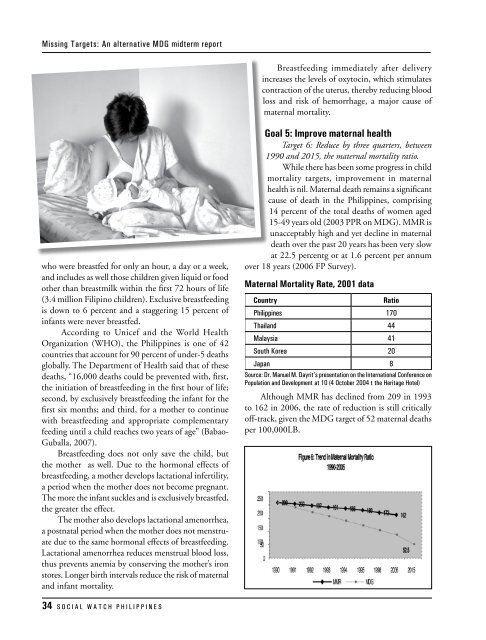one big file - Social Watch
one big file - Social Watch
one big file - Social Watch
You also want an ePaper? Increase the reach of your titles
YUMPU automatically turns print PDFs into web optimized ePapers that Google loves.
Missing Targets: An alternative MDG midterm report<br />
Breastfeeding immediately after delivery<br />
increases the levels of oxytocin, which stimulates<br />
contraction of the uterus, thereby reducing blood<br />
loss and risk of hemorrhage, a major cause of<br />
maternal mortality.<br />
who were breastfed for only an hour, a day or a week,<br />
and includes as well those children given liquid or food<br />
other than breastmilk within the first 72 hours of life<br />
(3.4 million Filipino children). Exclusive breastfeeding<br />
is down to 6 percent and a staggering 15 percent of<br />
infants were never breastfed.<br />
According to Unicef and the World Health<br />
Organization (WHO), the Philippines is <strong>one</strong> of 42<br />
countries that account for 90 percent of under-5 deaths<br />
globally. The Department of Health said that of these<br />
deaths, “16,000 deaths could be prevented with, first,<br />
the initiation of breastfeeding in the first hour of life;<br />
second, by exclusively breastfeeding the infant for the<br />
first six months; and third, for a mother to continue<br />
with breastfeeding and appropriate complementary<br />
feeding until a child reaches two years of age” (Babao-<br />
Guballa, 2007).<br />
Breastfeeding does not only save the child, but<br />
the mother as well. Due to the hormonal effects of<br />
breastfeeding, a mother develops lactational infertility,<br />
a period when the mother does not become pregnant.<br />
The more the infant suckles and is exclusively breastfed,<br />
the greater the effect.<br />
The mother also develops lactational amenorrhea,<br />
a postnatal period when the mother does not menstruate<br />
due to the same hormonal effects of breastfeeding.<br />
Lactational amenorrhea reduces menstrual blood loss,<br />
thus prevents anemia by conserving the mother’s iron<br />
stores. Longer birth intervals reduce the risk of maternal<br />
and infant mortality.<br />
Goal 5: Improve maternal health<br />
Target 6: Reduce by three quarters, between<br />
1990 and 2015, the maternal mortality ratio.<br />
While there has been some progress in child<br />
mortality targets, improvement in maternal<br />
health is nil. Maternal death remains a significant<br />
cause of death in the Philippines, comprising<br />
14 percent of the total deaths of women aged<br />
15-49 years old (2003 PPR on MDG). MMR is<br />
unacceptably high and yet decline in maternal<br />
death over the past 20 years has been very slow<br />
at 22.5 percentg or at 1.6 percent per annum<br />
over 18 years (2006 FP Survey).<br />
Maternal Mortality Rate, 2001 data<br />
Country<br />
Ratio<br />
Philippines 170<br />
Thailand 44<br />
Malaysia 41<br />
South Korea 20<br />
Japan 8<br />
Source: Dr. Manuel M. Dayrit’s presentation on the International Conference on<br />
Population and Development at 10 (4 October 2004 t the Heritage Hotel)<br />
Although MMR has declined from 209 in 1993<br />
to 162 in 2006, the rate of reduction is still critically<br />
off-track, given the MDG target of 52 maternal deaths<br />
per 100,000LB.<br />
34 S O C I A L W A T C H P H I L I P P I N E S

















